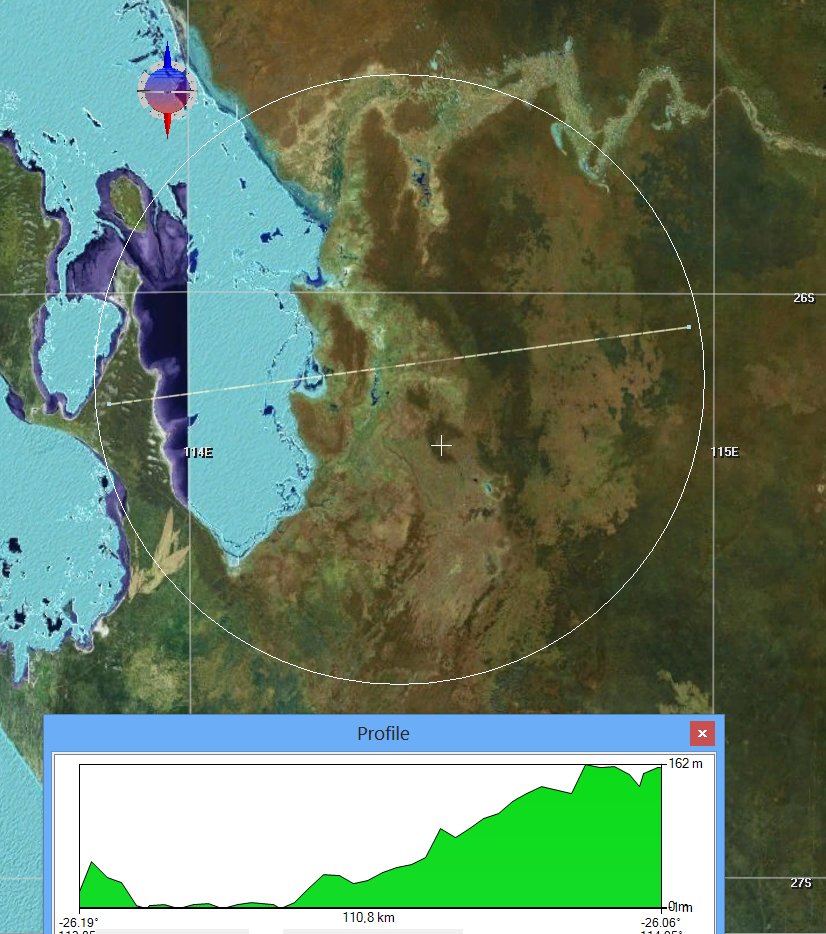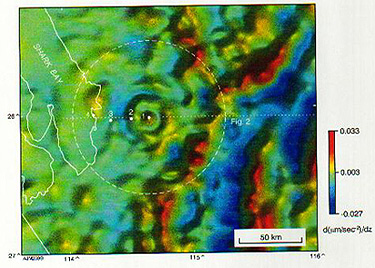
Спутниковый снимок и разрез из ITRIS (Integrated Tsunami Research and Information System, И.В.Маринин). 
Карта гравитационных аномалий кратера Вудлэй (Earth impact database).
|

Спутниковый снимок и разрез из ITRIS (Integrated Tsunami Research and Information System, И.В.Маринин). 
Карта гравитационных аномалий кратера Вудлэй (Earth impact database).
|
Мелководные морские диамиктиты позднего девона в пределах "филлит-кварцитовой группы" Пиритового пояса Пиренейского полуострова (Южно-Португальская зона Герцинского массива) обычно интерпретируются как мегаселевые потоки, связанные с тектонизмом. Потенциально импактокластический слой (дистальные выбросы).
(Dfaz-Martfnez, 2000).
Возраст воздействия Вудли ограничен вышележащими нижнеюрскими слоями, переработанными Раннепермскими палиноморфами в юрском озерном разрезе и деформированными нижнедевонскими и более древними отложениями. Региональное термальное событие, идентифицированное по следу расщепления апатита как 280-250 млн лет назад, указывает на возможную границу перми и триаса, хотя отсутствие триасовых отложений в кратере свидетельствует в пользу позднетриасового возраста. Учитывая размеры кратера, вполне вероятно, что Вудли, по аналогии с другими мегаударами (Маникуаган - поздний триас; Мороквенг; Чиксулуб - К-Т граница; Попигай и Чесапик залив - поздний эоцен) был связан с вымиранием.
Таким образом, до-нижнеюрский и пост-среднепермский возраст Вудли позволяет предположить, что он может либо принадлежать к позднетриасовому импактному кластеру, либо представлять собой пограничный импакт перми-триаса. Подсказкой, подтверждающей последнюю возможность, может служить температурный максимум на отметке 280-250 Ма, определяемый по следам деления апатита
(Glikson, 2000).
Строение, результаты гравитационных и магнитных исследований, данные по химическому составу вещества псевдотахилитовых прожилок в гранитоидах и возраст многокольцевого ударного бассейна Вудлей размером 120 км, Западная Австралия. Ударное образование структуры подтверждено наличием центрального гранитоидного поднятия размером 25 км, ударно-индуцированных планарных деформаций в зернах кварца, диаплектической витрификации полевого шпата, обширного псевдотахилитового жилкования и термически измененного слоя диамицитов, погребенных 380 м слоем озерных отложений нижнего юраса. Обогащение вещества прожилок Al, Ca, Mg, Ni, Co, Cr, V, S и обеднение K, Si обусловлено фракционированием элементов при ударном испарении, внедрением и испарением метеоритного компонента и минерализацией сульфидов. Возраст структуры (280-290 млн лет) свидетельствует о падении тела на границе перми-триаса
(Mory, Iasky, Glikson, Pirajno, 2000).
С использованием базы данных GONIAT проанализированы количественные и качественные изменения в эволюции аммоноидей на двух критических интервалах. В обоих случаях перед границей или на ней вымерло несколько крупных групп. Другие группы появились после границы. Лишь немногие виды смогли пересечь указанные рубежи. Во всех случаях наиболее значительные изменения затронули внутренние обороты раковины, ее скульптуру и общие очертания, включая размеры.Сходство в эволюции аммоноидей на обоих рубежах выражается в ступенчатом сокращении разнообразия перед границей - от фазы высокого разнообразия к фазе низкого разнообразия. После точки наименьшего разнообразия появляются новые группы с широкими, но низкими оборотами и малой степенью инволютности. Фаза высокого разнообразия начинается с появления раковин с более сложной формой и скульптурой. Причины глобальных изменений аммоноидей могли быть комплексными: тектоническими, климатическими, эвстатическими и т.д. Не исключается и влияние астероидного импакта
(Kullmann, 2002).
Оценка первоначального размера сильно эродированной и погребенной под слоем отложений ударной структуры Вудлэй. Гидротермальное плавление и диаплектические превращения сильно замаскированы крупномасштабным изменением подвергнутых удару гнейсов в монтмориллонитовые глины. Выявлено загрязнение пород структуры метеоритным компонентом. Первичный размер кратера составлял 120 км, возраст около 360 млн лет. Структура имела центральный купол диаметром 37 км
(Glikson, Mory, Iasky, Pirajno, Golding, Uysal, 2005).
Данные по хим. составу гидротермально измененных ударно-метаморфизованных (P>20 ГПа) гнейсов фундамента ударной структуры Wittenoom, Западная Австралия. Идентификация первичных минералов гнейсов сильно затруднена их обширным замещением монтмориллонитом, иллитом и серицитом. Хим. состав вторичных минералов отличен от состава вмещающих их гнейсов. Они обогащены относительно тугоплавкими элементами и обеднены летучими. Наблюдаемое обогащение ударно-измененных гнейсов и пронизывающих их вторичных глинистых минералов ферромагнезиальными Ni, Co, Cr и высокие отношения Ni/Co и Ni/Cr обусловлены внедрением в гнейсы богатых сидерофильными элементами флюидов ударника.
(Glikson, Eggins, Golding, Haines, Iasky, Mernagh, Mory, Pirajno, Uysal, 2005).
Влияние гидротермальных процессов, возникающих за счет превращения кинетической энергии падающих на Землю метеоритов в тепловую, на окружающие породы на примере ударных кратеров Шуэмакер, Вудлэй и Яррабубба, вокруг и внутри которых обнаружены гидротермальные флюиды. Показано, что протекание процессов от раннего высокотемпературного щелочного метасоматоза к более позднему низкотемпературному метасоматозу приводит к замещению первичных пород ассоциацияями водусодержащих минералов. В этих процессах могут образовываться и экономически значимые запасы полезных ископаемых
(Pirajno, 2005).